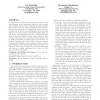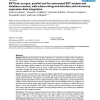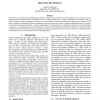543 search results - page 64 / 109 » Exploiting content redundancy for web information extraction |
IISWC
2008
IEEE
14 years 2 months ago
2008
IEEE
Web 2.0 represents the evolution of the web from a source of information to a platform. Network advances have permitted users to migrate from desktop applications to so-called Ric...
WWW
2009
ACM
14 years 8 months ago
2009
ACM
Comprehensive coverage of the public web is crucial to web search engines. Search engines use crawlers to retrieve pages and then discover new ones by extracting the pages' o...
CIKM
2010
Springer
13 years 6 months ago
2010
Springer
In this paper we investigate the task of Entity Ranking on the Web. Searchers looking for entities are arguably better served by presenting a ranked list of entities directly, rat...
BMCBI
2008
13 years 7 months ago
2008
Background: Expressed sequence tag (EST) collections are composed of a high number of single-pass, redundant, partial sequences, which need to be processed, clustered, and annotat...
LREC
2010
13 years 9 months ago
2010
Folksonomies are unsystematic, unsophisticated collections of keywords associated by social bookmarking users to web content and, despite their inconsistency problems (typographic...



